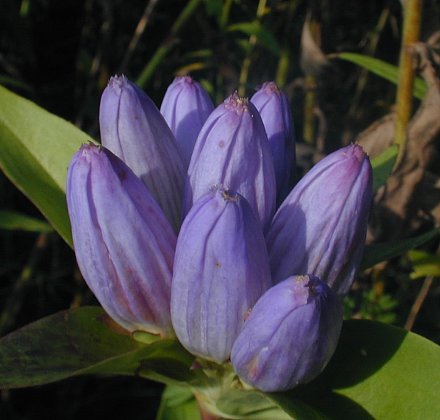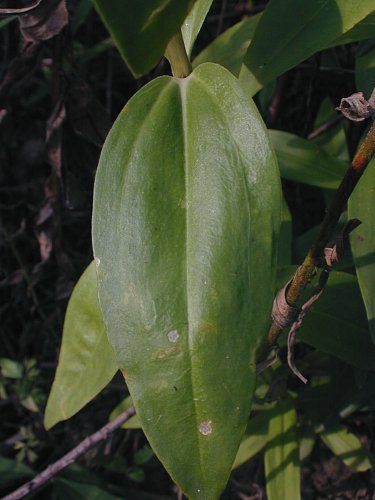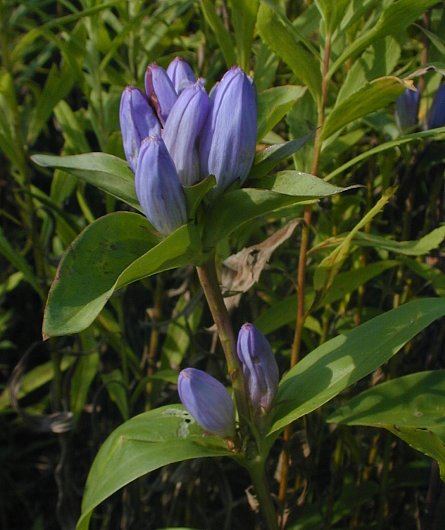Description: This perennial plant is 1-2' tall. Multiple stems can emerge from the taproot, otherwise this plant is unbranched. The central stem is round, hairless, and either light green or purple. The opposite leaves are up to 4½" long and 2" across, and sessile against the stem. They are broadly lanceolate or ovate, with smooth margins and parallel venation. The upper surface of each leaf is dark green and often shiny, while both the upper and lower surfaces are devoid of hairs. The uppermost tier of leaves is often whorled. The apex of the stem terminates in a cluster of flowers immediately above the whorled leaves, while smaller clusters of flowers may develop from the axils of the upper pairs of leaves. These flowers are bottle-shaped, looking like oversized flowerbuds even when mature, and they are 1–1½" long. The corollas are violet, and will assume different shades of this color depending on the maturity of each flower. There are longitudinal ridges along the outer edge of the corolla, providing it with a wrinkly appearance. The corolla remains closed at the top even when the flower is ready to receive pollinating insects. Inside, the reproductive structures of the flower are fused together to form a central column. The corolla usually has 5 lobes, but these are barely noticeable because of an interconnecting fringe that is even taller than the lobes. The green calyx is much smaller than the corolla, and divided into 5 lanceolate segments. These segments may curl outward away from the flower rather than remaining upright.

The blooming
period can occur from late summer to early fall, and usually lasts
about a month. There is no noticeable floral scent. The small seeds can
be transported by water or wind some distance from a mother plant. The
root system consists of a stout taproot. Vegetative reproduction does
not normally occur.
Cultivation:
The preference is full or partial sun, and moist rich soil. It is
easier to start with potted plants rather than seed, as germination can
be erratic and seedling mortality can be high. Mature plants are rarely
bothered by foliar disease or leaf-chewing insects. The worst threat is
droughty conditions, but appropriate placement of plants will mitigate
this problem.

Range &
Habitat:
The native Bottle Gentian is occasional in the northern half of
Illinois and
uncommon in the rest of the state (see Distribution
Map). However, populations of the plant are probably
declining as a result of the destruction of wetlands. Habitats include
moist black soil prairies, openings in floodplain forests, thickets,
fens, and swampy areas near bodies of water. This plant often occurs in
calcareous soil.
Faunal Associations:
Bumblebees are the primary pollinators of the flowers, as they are one
of the few insects that can force their way past the closed corolla.
This floral characteristic excludes smaller insects that are less
efficient at pollination from robbing nectar and pollen from the
bumblebees. Because the foliage and roots are bitter-tasting, mammalian
herbivores usually don't use this plant as a food source. However, deer
may chomp off the tender tops of the plants before they have a chance
to flower. This can cause the central stem to form smaller side
branches. The seeds are too small to be of much interest to birds. The
ecological value of Bottle Gentian is low, notwithstanding the appeal
of the flowers to humans.
Photographic Location:
The photographs were taken of plants growing in a mesic prairie at
Meadowbrook Park in Urbana, Illinois.

Comments: Bottle Gentian is a wierd-looking plant with a striking appearance. The adorable flowers are often deep violet, although other shades also occur, even in the same cluster of flowers. The only other gentian that this species can be confused with (among those that occur in Illinois) is Gentiana saponaria (Soapwort Gentian). Usually, Soapwort Gentian is pale violet or greyish blue, while the interconnecting fringe of the corolla is shorter than, or equal to, the length of the lobes. This interconnecting fringe is always taller than the lobes in the corolla of the Bottle Gentian. Sometimes the segments of the calyx curve outward in the Bottle Gentian, while they remain reasonably upright in the Soapwort Gentian, but this is not always a reliable distinction.